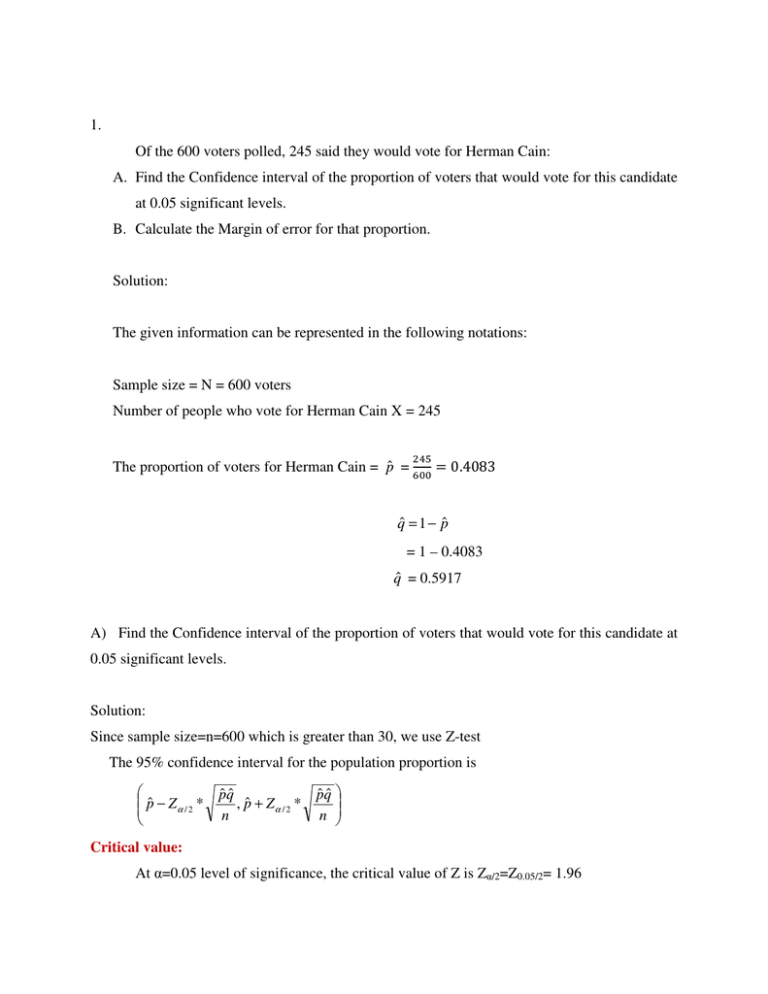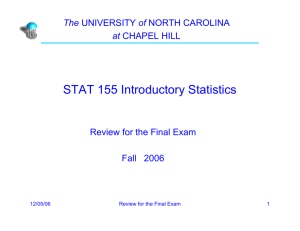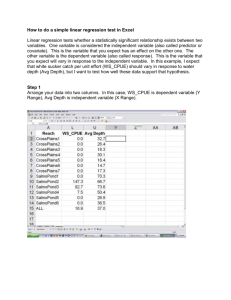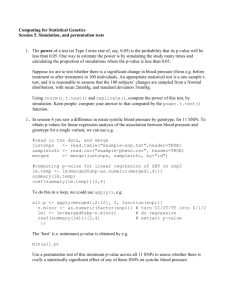1. Of the 600 voters polled, 245 said they would vote... A. Find the Confidence interval of the proportion of...
advertisement

1. Of the 600 voters polled, 245 said they would vote for Herman Cain: A. Find the Confidence interval of the proportion of voters that would vote for this candidate at 0.05 significant levels. B. Calculate the Margin of error for that proportion. Solution: The given information can be represented in the following notations: Sample size = N = 600 voters Number of people who vote for Herman Cain X = 245 The proportion of voters for Herman Cain = p̂ = 0.4083 qˆ = 1 − pˆ = 1 – 0.4083 q̂ = 0.5917 A) Find the Confidence interval of the proportion of voters that would vote for this candidate at 0.05 significant levels. Solution: Since sample size=n=600 which is greater than 30, we use Z-test The 95% confidence interval for the population proportion is pˆ − Zα / 2 * pˆ qˆ , pˆ + Zα / 2 * n pˆ qˆ n Critical value: At α=0.05 level of significance, the critical value of Z is Zα/2=Z0.05/2= 1.96 By substituting the values in the above formula we get, 0.41 * 0.59 0.41 * 0.59 0.41 − 1.96 * , 0 . 41 + 1 . 96 * 600 600 (0.41 − 1.96 * 0.020079,0.41 + 1.96 * 0.020079) (0.41 − 0.03935,0.41 + 0.03935) (0.369, 0.447) Hence 95% confidence interval estimate of the proportion of votes is (37%, 45%). /---------------------------/ Calculate the Margin of error for that proportion. Solution: Margin of Error: E = Zα / 2 * E = 1.96 * pˆ qˆ n 0.41* 0.59 600 Therefore, the margin of error for the given proportion is 0.020079. /---------------------/ Problem: 2 The data below represents the ages of undergraduate students at Harper College and Daley College. Use the information to answer questions 27 to 29. Harper: Daley College Number Sampled = 14 Number = 12 Mean = 21 Mean = 22 Standard Dev = 2.5 SD = 2.8 1. Perform the requested operation: C. Find the Critical Value of t to test the claim that the ages of students in the two colleges are similar at 0.05 significant levels. D. Calculate the Confidence interval of the Mean for Harper College students Solution: C) At α = 0.05 level of significance, the critical value of t with (n1+n2-2) =24 degrees of freedom is given by tα / 2, n −1 = t0.025, 24 df = 2.3909 (by referring t-distribution table) By substituting the values in the above formula we get, /----------------/ d) The 95% confidence interval for the difference between the two population means is given by s2 s2 ( X 1 − X 2 ) − t0.025 * 1 + 2 , n1 n2 ( X 1 − X 2 ) + t0.025 * s12 s22 + n1 n2 From the above table, we have 2.52 2.82 2.52 2.82 + , (21 − 22) + 2.3909 * + (21 − 22) − 2.3909 * 14 12 14 12 [–3.507, 1.507] Thus, the 95% confidence interval for the difference between the two population means is [–3.507, 1.507]. /---------------------/ 3. Perform the requested operation: A. Find the Critical Value of F to test the claim that the ages of students in the two colleges are similar at 0.05 Significant level. B. Calculate the Coefficient of variation for the two groups and interpret them Solution: A. The Critical value of F is given by, F0.05, 14,12 = 2.64 (by referring F-table) B. The coefficient of variation is a calculation built on other calculations -- the standard deviation and the mean -- as follows: C.V = 11.90 Problem: 4 In a clinical experiment, a researcher wants to test the effect of Medical Marijuana on Glaucoma patients. He conducts a double-blind study using marijuana and a placebo (fake weed). The table below summarizes the data on patient response of ‘feeling better’. With 95% Confidence, should medical marijuana be recommended? Questions correctly answered Questions answered correctly Placebo Group n = 42 Mean = 43.14 SD = 7.74 Marijuana Group n = 34 Mean = 40.76 Var = 61.15 Solution: The given information can be represented in the following notations: Sample size of Placebo Group = n1 = 42 Sample size Marijuana Group = n2 = 34 Sample mean of Placebo Group = X 1 = 43.14 Sample mean of Marijuana Group = X 21 = 40.76 Sample standard deviation = S1 = 7.74 Sample standard deviation = S2 = 7.82 Hypotheses: Null hypothesis: H0 : With 95% Confidence, medical marijuana can be recommended. Alternate hypothesis: H1 : With 95% Confidence, should medical marijuana cannot be recommended. Using Microsoft addins called Megastat we get, Hypothesis Test: Independent Groups (z-test) Placebo Group 42 7.74 43 Marijunana Group 34 7.82 41 8.000 1.698 0 4.71 2.47E-06 4.671 11.329 3.329 mean std. dev. n difference (Placebo Group - Marijunana Group) standard error of difference hypothesized difference z p-value (two-tailed) confidence interval 95.% lower confidence interval 95.% upper half-width F-test for equality of variance 61.1524 59.9076 1.02 .9458 variance: Marijunana Group variance: Placebo Group F p-value Conclusion: Since the P-value (0.9458) corresponding to the value of test statistic (4.71) is greater than 0.05, there is sufficient evidence to accept the null hypotheses at 5% level. Hence we conclude medical marijuana can be recommended. Procedure: Problem: 5 A researcher wants to know if the Race and having a Single parent has an factor on gun violence in a small town. A small group of that town residents were surveyed on their experience with violence involving a family member. The computer printout of the ANOVA table below summarizes the results. Interpret your results. Two-Way ANALYSIS OF VARIANCE Source Sum of Squares Degrees of freedom Mean square F-ratio Significance of F Race Single parent Interaction Residue 10.00 0.42 0.41 3.17 1 1 1 6 10.00 0.42 0.41 0.53 18.87 0.79 0.77 0.03 .40 .41 Total 14 9 A. Interpret your results using the classical approach (F-value only) B. Using α = 0.05, interpret your results using the p-value approach (p-value and alpha) Solution: a) From the above table, we have The p-value of the main effect Race is 0.03 The p-value of the main effect Single Parent is 0.40 The p-value of the interaction is 0.41 b) Conclusion: Since the p-value of the main effect Race is less than 0.05, we reject the null hypothesis at 0.05 level of significance. Hence we conclude that at least two population means differ significantly among the levels of the factor Race Since the p-value of the main effect Single Parent is greater than 0.05, we do not reject the null hypothesis at 0.05 level of significance. Hence we conclude that there is no significant difference in population means among the levels of the factor Single Parent Since the p-value of the interaction effect Race and Single Parent is greater than 0.05, we do not reject the null hypothesis at 0.05 level of significance. Hence we conclude that there is no significant difference in the interaction between the factors Race and Single Parent. /-----------------------/ 29. Perform the requested operations: (10 points) a. Before a student takes a Statistics prep class, he or she must take a pretest and then a posttest after the completion of the course. Typical results for two students are shown in the table below. Pretest 510 475 Posttest 662 620 i. Which is the independent variable? ii. Write an equation that models the test scores iii. Interpret the model Solution: (i) (ii) Pretest is the independent variable, because pretest is taken before completion of the course Pretest Vs Posttest 665 y = 1.2x + 50 R² = 1 660 655 Posttest 650 645 640 635 630 625 620 615 470 480 490 500 510 520 Pretest (iii) As the X-values increases the Y value also increase using regression equation. /----------------------/ b. The cost of one day car rental is the sum of the rental fee, $100, plus $.78 per mile. i. Write an equation that models the cost associated with renting a car. Solution: Y =. $78x + $100 ii. Interpret the model Solution: As the number of miles increase the rental cost of the car also increases. iii. Find the cost of renting a car and driving it for 1000 miles. Solution: Y =. $78x + $100 Y =. $78(1000) + $100 Y = $880 Therefore, the cost of renting a car and driving it for 1000 miles is $880. 30. Administrators wanted to predict a students grade on a Senior College Statistics Midterm based on his/her SAT score. A sample of ten past senior students was selected and their recorded SAT scores and Midterm scores listed. The table below summarizes that data. (15 points) Student ID AB CD EF GH IJ LM NO PQ RS TZ • SAT score (Independent Variable) x 1100 1300 1000 1100 1200 1200 1400 1300 1000 1400 Midterm score (Dependent Variable) y 89 92 86 92 90 93 98 95 88 95 Use your calculator or statistical software to sketch the scatter plot for this data and determine the correlation coefficient (r) between SAT and Midterm scores. Solution: SAT score (x) VS SAT score (y) 100 98 y = 0.022x + 65.4 R² = 0.809 SAT Score (y) 96 94 92 90 88 86 84 500 700 900 1100 SAT Score (x) 1300 1500 • With α = 0.05, test the statistical significance of (r) in (a) above. Solution: ANOVA table Source Regression Residual Total SS 96.8000 22.8000 119.6000 df 1 8 9 MS 96.8000 2.8500 F 33.96 Regression output variables coefficients std. error t (df=8) Intercept SAT Score (x) 65.4000 4.5612 14.338 p-value 5.46E07 0.0220 0.0038 5.828 .0004 p-value .0004 confidence interval 95% 95% lower upper std. coeff. 54.8817 75.9183 0.000 0.0133 0.0307 0.900 Since P-value is less than the 0.05, there is a significant difference. • 2 What is value of r and what does it tell you? Solution: R² = 0.809 It will represent the proportion of common variation in the two variables (i.e., the "strength" or "magnitude" of the relationship). In order to evaluate the correlation between variables, it is important to know this "magnitude" or "strength" as well as the significance of the correlation. • Determine the equation of the regression line for this data Solution: The equation of the regression line for this data is y = 0.022x + 65.4 • Predict the Midterm score for a student who had a score of 1275 on the SAT Solution: y = 0.022x + 65.4 y = 0.022(1275) + 65.4 y = 93.45 Therefore, the predicted the Midterm score for a student who had a score of 1275 is 93.45. /---------------------------/ 31. The following table gives the mean daily calorie intake and infant mortality rate (deaths per 1000 live births) for ten countries. (15 points) Country Infant Mortality Rate Mean Daily Calories (Independent Variable) (Dependent Variable) x y Afghanistan 154 1523 Austria 6 3495 Burundi 114 1941 Colombia 24 2678 Ethiopia 107 1610 Germany 6 3443 Liberia 153 1640 New Zealand 7 3362 Turkey 44 3429 USA 7 3671 i. Use your calculator or statistical software to sketch the scatter plot for this data. Does there appear to be a correlation between the variables? If so describe the correlation. Solution: IMR VS MDC Mean Daily Calories 4000 3500 3000 y = -13.53x + 3521. R² = 0.884 2500 2000 1500 0 50 100 Infant Mortality Rate 150 200 ii. Determine the correlation coefficient (r) between Infant Mortality and Calorie intake. Solution: Correlation Matrix Infant Mortality Rate Mean Daily Calories Infant Mortality Rate 1.000 -.941 10 ± .632 ± .765 Mean Daily Calories 1.000 sample size critical value .05 (two-tail) critical value .01 (two-tail) iii. With α = 0.05, test the statistical significance of R in (b) above. iv. The regression analysis is carried out in Excel (Data Data Analysis Regression Analysis selection of the variables) and the output is given below: ANOVA table Source Regression Residual Total SS 6,517,718.2501 848,149.3499 7,365,867.6000 df 1 8 9 MS 6,517,718.2501 106,018.6687 F 61.48 Regression output variables coefficients std. error t (df=8) 3,521.2450 148.7793 23.668 p-value 1.08E08 3,178.1594 3,864.3306 -13.5377 1.7266 -7.841 .0001 -17.5192 -9.5562 Intercept Infant Mortality Rate p-value .0001 confidence interval 95% lower 95% upper Since the p-value is less than 0.05 , there is significant difference between two variables. 2 v. What is the value of r and what does it tell you? Solution: R² = 0.884 It will represent the proportion of common variation in the two variables (i.e., the "strength" or "magnitude" of the relationship). In order to evaluate the correlation between variables, it is important to know this "magnitude" or "strength" as well as the significance of the correlation. vi. Find the regression equation for this data Solution: Therefore, the regression equation for this data is y = -13.53x + 3521. vii. Use the regression equation to estimate the infant mortality rate for a country with a mean daily calorie intake of 2800 calories. Solution: y = -13.53x + 3521. y = -13.53(2800) + 3521. y = 3328. Therefore, the regression equation to estimate the infant mortality rate for a country with mean daily calorie intake of 2800 calories is 95. /-----------------------/







